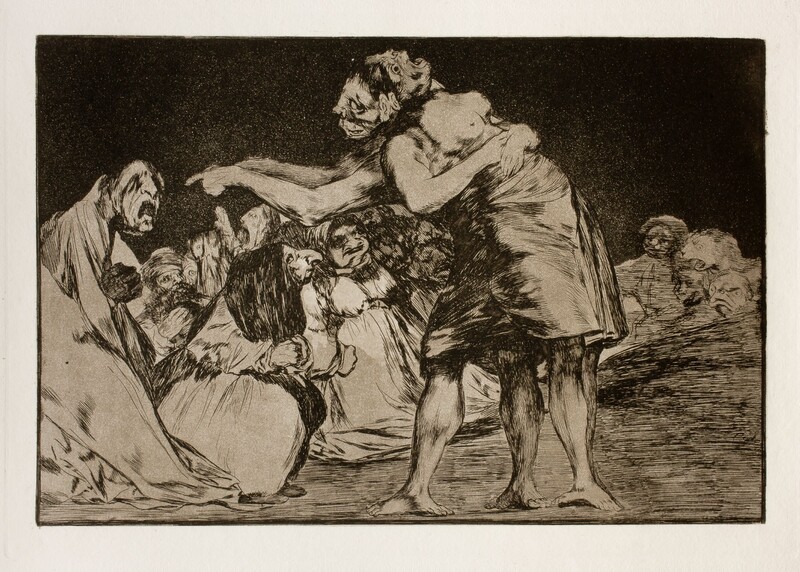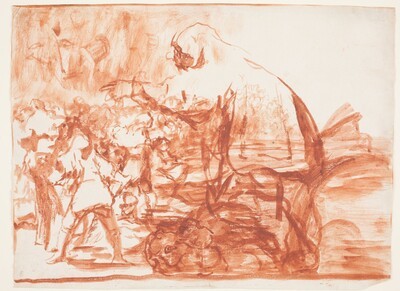- Cronología
- 1815 - 1819
- Dimensiones
- 247 x 359 mm
- Técnica y soporte
- Aguafuerte, aguatinta y punta seca
- Reconocimiento de la autoría de Goya
- Documented work
- Ficha: realización/revisión
- 21 Aug 2021 / 05 Jun 2023
- Inventario
- -
Goya (print, on the right-hand side, inverted)
See Femenine folly.
There is a state proof before the aquatint in the Lazaro Galdiano Foundation in Madrid in which the manuscript 1ª appears in the upper left-hand corner.
The Art Institute of Chicago print has a 4 manuscript in the upper left corner and the title Disordered folly centred in the lower margin.
The proteagonist of this scene is a monstrous androgynous being, half man and half woman. His female part is clear, as his naked chest revelas his breasts, while the other part has no clearly masculiine features except for his calves. His legs are bipedal. The female half has round eyes and an open mouth, while the male half has a deformed face and points with his hands to another figure at the left edge of the composition. He crosses his hands in adoration and his face has drooping features and an open mouth. Next to her is an aquiline-nosed old woman in a toquilla, who also appears to be praying, and another fat, flat woman. Behind these three figures is a large group of heads. One can be seen with a beard and turban, another with an open mouth, and many others are blurred. On the far right, the heads are in the shape of animals.
The meaning of this print is cryptic, very difficult to decipher. It has been likened to Caprice 75. No one can untie us, in which Goya satirizes the indissolubility of marriage. In fact, the figure on the left is identified with a clergyman, as he wears a kind of habit, so that the horrible Siamese character would point at him, accusing him of being guilty of their devastating union. However, this interpretation is not the most widely accepted. The most famous is the one that focuses on the deformity or animalisation of the characters. According to it, the print is a summary of all human aberrations, a sample of all the monsters that have tormented mankid. This is how Goya saw the world: disordered, confused and anarchic. With the print he sought to criticise those who were incapable of distinguishing between good and evil, contributing with their consent to the dominance of the latter.
The possible preparatory drawing for the present print, also titled Disordered folly has survived.
-
Etchings by Francosco GoyaJohannesburgoJohannesburgo1974
-
1976
-
Grabados de Goya: colección propiedad de la Biblioteca Nacional, que se conserva en su Gabinete deCasa de la Amistad de MoscúMoscow1979exhibition displayed from January 18th to 31st 1979
-
Goya. Das Zeitalter der Revolucionen. Kunst um 1800 (1980 – 1981)Hamburger KunsthalleHamburg1980cat. 150
-
Goya y el espíritu de la IlustraciónMuseo Nacional del PradoMadrid1988from October 6th to December 18th 1988. Exhibited also at Museum of Fine Arts, Boston, January 18th to March 26th 1989; The Metropolitan Museum of Art, Nueva York, May 9th to July 16th 1989, Madrid curator Manuela B. Mena Marqués, scientific directors Alfonso E. Pérez Sánchez and Eleanor A. Sayre
-
Ydioma universal: Goya en la Biblioteca NacionalBiblioteca NacionalMadrid1996from September 19th to December 15th 1996cat. 304
-
Francisco Goya. Sein leben im spiegel der graphik. Fuendetodos 1746-1828 Bordeaux. 1746-1996Galerie KornfeldBern1996from November 21st 1996 to January 1997
-
Goya. 250 AniversarioMuseo Nacional del PradoMadrid1996consultant editor Juan J. Luna. From March 29th to June 2nd 1996
-
Goya grabadorMuseo del Grabado Español ContemporáneoMarbella1996from March 8th to May 5th 1996
-
Zaragoza1996
-
London1997
-
1999
-
Madrid1999
-
Schlaf der Vernunft. Original radierungen von Francisco de GoyaMunich2000
-
Bilbao2012
-
Goya et la modernitéPinacothèque de ParisParís2013from October 11st 2013 to March 16th 2014cat. 207
-
Zaragoza2021
-
2022
-
OxfordBruno Cassirer1964pp. 384-385, cat. 254
-
Vie et ouvre de Francisco de GoyaParísOffice du livre1970p. 325, cat. 1581
-
Catálogo de las estampas de Goya en la Biblioteca NacionalMadridMinisterio de Educación y Cultura, Biblioteca Nacional1996p. 238, cat. 381
-
MadridReal Academia de Bellas Artes de San Fernando y Calcografía Nacional1996pp. 105 y 109, cat. 8 y 27
-
Roma Edizioni de Luca2000pp. 124-125, cat. 39
-
ParísPinacoteca de París2013p. 272
-
Goya. In the Norton Simon MuseumPasadenaNorton Simon Museum2016pp. 204-211
-
Goya. Traveler and artist of the Grand Tour (exp. cat.)ZaragozaGobierno de Aragón2021pp.224-225
-
Museo de Bellas Artes de Badajoz y Diputación de Badajoz2022p. 95

